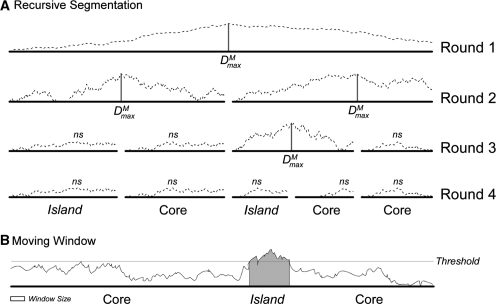Figure 1.
Schematic representation of recursive segmentation and moving-window methods for island detection. (A) The recursive segmentation technique. The dashed line shows the value of MJSD, Dm, across each possible split location. If Dmaxm is statistically significant, the sequence is segmented at that point, represented by a vertical bar. In this example, four splits are made resulting in five segments; values of Dmaxm that are not significant are denoted as ns. Comparison of segments to the genome as a whole shows two segments are islands and three represent the core genome. (B) The moving-window technique. Values are calculated for windows of a specified size; windows with values over a predetermined threshold are identified as atypical and annotated as an island (gray region). Here, there is insufficient signal for the 5′ region to be marked as a putative island, resulting in a false negative.

